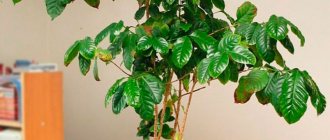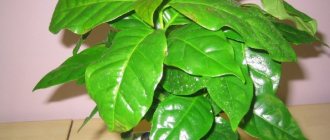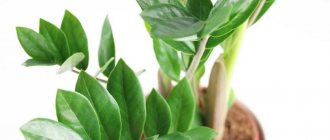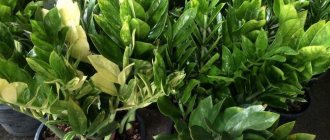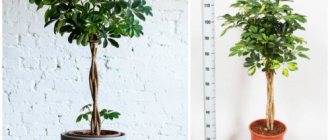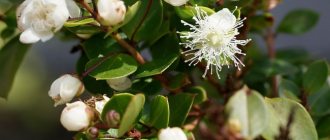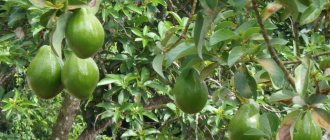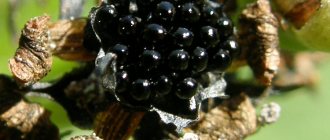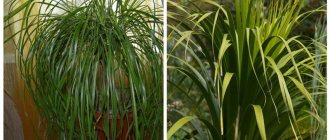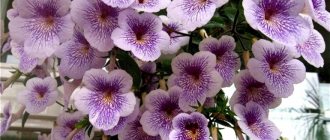General information about the coffee tree
Ethiopia is considered the birthplace of coffee. The plant is an evergreen. The height of trees in natural conditions reaches 10 m, and on plantations - 2.5 m. The branches are shortened to facilitate care and harvesting.
For cultivation at home, plants up to 1 m high are used. Coffee blooms from mid-spring to mid-autumn.
Beneficial features
Grains contain vitamins:
- IN 1;
- AT 2;
- RR.
The seeds contain macro- and microelements:
- iron;
- potassium;
- phosphorus;
- sodium;
- calcium;
- magnesium.
The seeds contain iron, potassium and phosphorus.
Caffeine benefits the body. It relieves headaches. The substance tones the brain, having a stimulating effect. Caffeine helps with nervous exhaustion and increased fatigue.
Tree structure
You can recognize the plant in the photo by its spreading branches. The berries located on them resemble bunches of grapes.
Fruit
The oblong or spherical fruit is called a cherry. After flowering ends, ripening lasts up to 8 months.
The cherry turns a bright red color. It contains from 1 to 3 seeds. The size of the berry does not exceed 1.5 cm.
Root system
The structure of the root system is taproot. The depth of germination depends on the type of coffee. Robusta roots have a depth of no more than 2 m. Arabica grows at 2.5-3 m.
Flowers
The white flowers have a scent reminiscent of jasmine. The presence of male and female characteristics allows self-pollination. Inflorescences are arranged in bunches.
The flowers of the coffee tree have a strong aroma.
Crown
The height of the crown depends on the type of coffee. In the Congolese variety, it does not exceed 2 m. In Arabica, the crown height reaches 6 m. The branches of the tree are inclined to the ground.
Leaves
The leaves have a glossy surface. Their lifespan ranges from 3 to 5 years. The oval leaves reach 20 cm in length and 5 cm in width. The venation is pinnately uneven, reticulate.
Place for a plant
For a young tree you need to choose the right permanent location. The plant is quite capricious in this regard. It loves consistency. Even a slight turn of the plant will cause the leaves of the coffee tree to fall off.
Coffee appreciates light and moisture. But exposure to direct ultraviolet light can cause burns. Therefore, the south side, when shaded with newsprint, can actually become an ideal option for coffee.
The north side will not spoil the tree, but it will grow very slowly and bloom late.
Popular varieties
Scientists count more than 100 types of coffee. Plantation owners often cultivate Arabian and Congolese varieties. Hybrids of these varieties are also grown.
Arabian
The Arabian variety has become widespread. It blooms 2 times a year. Under natural conditions, Arabica reaches 7-8 m in height.
For home breeding, a dwarf variety is used, the height of which does not exceed 0.8 m.
Congolese
Congolese coffee is called Robusta, which means “strong”, “strong”. The variety is resistant to diseases and pests. Robusta is easy to care for and has high yields. The Congolese variety has a higher caffeine content. But its taste is lower than that of other varieties. Robusta is added to coffee blends.
Congolese coffee is easy to care for.
Liberian
The variety was discovered in Liberia. The first plantation appeared in 1864. Coffee was first planted in the Philippines. He was then transported to Indonesia. Here, the Liberian variety replaced the Arabica, which was destroyed by bad weather conditions. The grains have a strong aroma, but have a weak taste. For this reason they are used in mixtures. The caffeine content of the Liberian variety is reduced.
Coffee "Robusta"
Robusta coffee, or Congolese coffee (c. Canephora pierre)
, grows wild in the equatorial forests and savannas of the Congo Basin, mainly between 10° north latitude and 10° south latitude. Since the beginning of the 20th century, this type of coffee tree has become widespread throughout the world. Today it is an important economic crop, distributed mainly on the lower parts of the slopes, where the more fastidious Arabica cannot survive due to disease. It is no coincidence that the word “robusta” is translated as “strong”, “stable”.
Congolese coffee
has varieties: the tree-like form of robusta (Robusta), or canephora (Canephora), characterized by the large height of the trees and therefore requiring pruning, and the bush-like form of nganda (Nganda). The Congolese coffee tree reaches a height of 2-10 meters. It has larger, light green leaves than Arabica coffee. It blooms at the age of three years. The flowers are white and pink. The fruits ripen 10-11 months after flowering and are a round berry with a diameter of 1.2 centimeters.
A drink made from Robusta coffee is inferior in quality to a drink made from Arabica coffee. It is less tasty and not as fragrant. But, on the other hand, it has undoubted advantages over Arabica: it is more productive and cheaper, and tolerates diseases better.
After instant coffee appeared on the market, attitudes towards robusta changed for the better. It turned out to be very suitable for the production of this drink, primarily from an economic point of view. In addition, Robusta has another noteworthy quality: it successfully complements Arabica, combining its fullness of taste with its aroma.
↑ up
Features of growing at home
When growing coffee at home, they pay attention not only to the frequency of watering, the quality of fertilizer, but also to the choice of location. The window sill is only suitable for seedlings. The growing tree needs to be transplanted into a tub. It is unacceptable to leave the pot near heating devices. The sun's rays should not fall on it.
Coffee does not tolerate movement well, so you need to move it away from its usual place gradually. For example, the potty is placed on a chair next to the window. It is left there for several days. Then the chair must be moved 2 steps. Here he remains for another 2-3 days, etc.
The first harvest should not be eaten or used for making drinks. It is advisable to use the seeds for growing trees.
Planting a coffee tree
Coffee trees are suitable for spacious apartments and country houses. If several plants are in the same room, a distance of at least 1 m is established between plants.
Choosing a pot
The choice of pot depends on the diameter of the root system. Large containers should not be used. In such a pot, putrefactive processes and acidification of the soil are observed. The container in which the plant is planted should exceed the diameter of the root system by no more than 5 cm.
The size of the plant's root system affects the choice of pot.
Priming
Slightly acidic clay soil is suitable for coffee trees. It is advisable to purchase a ready-made substrate. You can prepare the soil yourself by mixing river sand, peat, humus and garden soil. The components are combined in equal proportions. The soil intended for planting azaleas and gardenias is also used as a substrate for coffee.
Plant care tips
Coffee is considered a capricious plant, sensitive to improper care. But if the necessary conditions are met, the tree bears fruit for many years.
Temperature
It is advisable that the temperature in the room where the seedlings are located does not exceed +25ºC. In winter, the thermometer should not fall below +12ºC. If the room temperature is above +25ºC, you need to ensure that the humidity does not fall below 65%.
Lighting
The plant is not a light-loving plant. The pot is placed on the north or west window. If a tree located in the shade does not bloom, it is worth moving it to a room facing the sunny side.
The coffee tree is not light-loving.
Watering
In the warm season, the tree is watered up to 3 times a week. In early spring, late autumn and winter, it is enough to moisten the soil once every 7 days. It is necessary to increase the frequency of watering at the first signs of wilting, which is indicated by dryness and yellowing of the leaves.
Feeding and fertilizer
Coffee requires several types of fertilizers. In spring, plants need nitrogen fertilizing. In the summer months, monosubstituted potassium phosphate should be added to the soil. In late autumn and winter, fertilizers are not applied. Watering during this period is reduced to once every 10 days.
Regardless of the time of year, the soil can be fertilized with citric acid. To prepare the fertilizer, dissolve 1 g of the substance in 1 liter of water. Citric acid can be used no more than once a month.
Transfer
Trees under 3 years old need replanting, which is carried out every year. Old soil and a small amount of fresh soil are poured into the pot. It is advisable to replant in the same place where the plant is permanently located. This will help coffee adapt to new conditions faster. After transplantation, the leaves are moistened with a spray bottle for 1-1.5 weeks.
Replantation is carried out every year.
Trimming
Standard trees do not need pruning. After shortening, the branches stop growing. If the owner intends to shape the crown, it is necessary to wait until the tree reaches a height of 0.5-0.7 m.
How to care in winter
In winter, caring for a coffee tree is slightly different from in summer. With the beginning of autumn, its growth slows down and the plant goes into a dormant state. Despite this, it is necessary that the room temperature be maintained at 18-20°C, and the shrubs should also be protected from drafts.
During the periods from November to March, when ultraviolet rays are not so active, you can illuminate the flower with a fluorescent lamp.
Is it possible to leave it while on vacation?
It is permissible to leave a houseplant without care during a business trip or vacation. However, the tree must be provided with a regular supply of moisture. You can buy a device for automatic watering. It will supply the soil with water for 14-20 days.
During the growing season, coffee requires more liquid. For this reason, it is worth removing the fruits and inflorescences.
An increase in moisture consumption is also observed during the growth of young shoots. To stop their development, you need to pinch the tops.
Kahwa drink - the “progenitor” of coffee
East Africa gave the world a cult drink. According to legend, this happened in the 800s AD. e. in Abyssinia (now Ethiopia). A goat herder from the city of Kaffa noticed a special interest of his four-legged charges in small mountain trees. After eating their leaves and colorful berries, the animals frolicked with unprecedented energy.
The Abyssinians quickly appreciated the energy tea, and the monks of the surrounding monasteries figured out how to dry and grind the berries. The fruits and drink received a name consonant with the city - Kahva.
By the 12th century, coffee culture had spread throughout the African continent and was later taken up by the Turks. It was they who came up with the brilliant idea in the 15th century to fry Kahwa grains over a fire and grind them into powder. Two centuries later, coffee from Egypt and Yemen came to Italy. The black drink created a sensation in the social salons of Venice, and soon its triumphal march began.
Interesting fact. The first coffee shops appeared in Venice. African Mocha was especially held in high esteem - coffee with an expressive aroma of dark chocolate and a tart taste. Opened in 1720, the coffee shop in Piazza San Marco delights visitors not only in the picture. The establishment operates today under the name “Florian”.
Reproduction methods
In addition to seeds, cuttings and the root system of coffee can be used for propagation. The first method is suitable for beginners. The second 2 are recommended for experienced gardeners.
Seeds
Fresh grains should be used. You can mix river sand with leaf soil. The soil must be sterilized. To do this, just keep it over steam for 15 minutes. Before planting, seeds are left in warm water for 2-2.5 hours. Then you need to make small cuts on them. This will soften the hard shell.
The coffee tree reproduces by seeds.
The seeds are only laid on the surface of the substrate. When buried in the ground they begin to rot. After planting, the seeds are watered and covered with plastic wrap. Ventilation is carried out 2-3 times a week. The film is removed for 2 hours. The first shoots sprout no earlier than after 6-8 weeks. Seedlings can be planted when the first leaves appear. Coffee will begin to bear fruit only after 3-4 years.
Vegetatively
For propagation, part of the root system is separated. It is necessary to choose a plant from 4-5 years old. Trees younger or older than this age may die when part of the root is separated. It is advisable to use this method in late autumn or early spring, when the movement of juices in the plant slows down. The detached part of the root is transplanted into a separate pot.
By cuttings
The length of the cuttings must be at least 8 cm. Each of them has 2 buds. The cuttings are planted in a container with loose soil, transferred to a warm room (with a temperature of 27ºC), and covered with plastic wrap. The soil is moistened with a spray bottle and ventilated daily for 2 hours. Replanting is possible when the coffee takes root.
Transplantation and propagation of Arabica Coffee flowers
Without changing the pot, it is impossible to grow a healthy, large and fruit-bearing tree. It is required every spring for young representatives. The new container is selected slightly larger than the previous one. For the adult “generation” such a need appears every 3 years. Over the next 2 years, the top layer of soil is replaced.
The Arabica coffee flower is propagated using two methods.
Cuttings
This is the most effective and convenient way. They are purchased at special flower shops. Before planting, they are kept for 3 hours in a special solution, which is purchased in the same place. After this, you can root in azalea substrate.
No temporary container is needed. Planted immediately into a permanent location. It takes about 2 months for the roots to form.
Seeds
The greatest difficulty is finding high-quality planting material. Store-bought products have most likely already lost their viability. It is better to find the owners of the tree and ask them for grain from their pet. The soil is prepared in advance. The seeds are soaked in a weak solution of potassium permanganate and watered with it at the end. Deepen 0.5-1 cm into the hole. For rapid emergence of seedlings, create greenhouse conditions and cover with a jar.
Disease and pest control
Trees often suffer from pests such as mealybugs, sooty fungus, scale insects and spider mites. Poor quality care leads to illness. In coffee there are:
- Leaf rotting. The problem is caused by overwatering. But if the leaves turn yellow and dry, the amount of liquid should be increased.
- The appearance of brown spots. This sign indicates a lack of nitrogen or phosphorus in the soil.
- The appearance of holes in the leaves. If pests are absent, perforation indicates sunburn.
- Slow growth. It is worth increasing the amount of fertilizers. The reason for slow growth may be lack of lighting.
- Yellowing of leaves. The roots should be checked for rotting. If green veins remain on yellow leaves, the soil has low acidity.
Prevention methods
To prevent the appearance of parasites, it is necessary to monitor the humidity of the room. Avoid dryness and drafts. At the same time, you also need to be wary of excess moisture. If cobwebs or white coating appear on the leaves, remove them with a soft sponge and a weak soap solution. The fertilizer used must contain all the necessary components. It is necessary to monitor the quality of the soil.
Buying a coffee tree in a store: what to look for
Arabian and Congolese varieties are more suitable for growing at home. It is advisable to buy mature coffee, the health of which can be assessed by the trunk. It is always thick and hard, but at the same time quite flexible. You need to pay attention to the leaves. They should be dark green, shiny, without visible damage.
A newly purchased tree must be isolated from other indoor plants for 3-4 weeks to avoid the transmission of parasites and diseases if present. Darkening or yellowing of leaves is not necessarily a sign of health problems. The cause of damage to greenery can be a change in environment or excess feeding.
Features of care
Immediately after planting the cuttings, the plant is kept in a bright place, but so that the sun's rays do not burn the leaves. When the top bud begins to grow and new leaves appear, you can transplant the Arabica into another pot and move it to a permanent place. If flowers appear on the tree, they do not need to be removed. This means that Arabica liked the local conditions.
Soil for coffee tree
To transplant rooted cuttings, it is necessary to prepare another soil, which consists of turf soil, peat and sand. The ratio of parts is 4:2:1. The sand must be calcined and the peat must be shed with potassium permanganate.
The turf is steamed in a water bath for an hour to remove fungal spores that can infect and kill the young tree. The soil should be slightly acidic. If it is not possible to prepare the mixture at home, you can buy it in the store.
After replanting Arabica coffee at home, water the soil well so that the soil adheres well to the roots. Air voids do not allow the tree to fully feed.
Watering
The earthen ball should never dry out, otherwise the plant will shed its leaves or flowers. Dry indoor air can cause leaves to turn yellow. To prevent this, it is recommended to spray the coffee tree greens with warm water daily.
The root system of Arabica is of two types - fibrous and mixed, when, as the roots grow in width, it develops 2 - 3 taproots.
Arabica fertilizers
How Arabica coffee grows can determine whether it has enough nutrients. For feeding, watering with mullein solution is used, as well as complex mineral fertilizers containing the main components - nitrogen, phosphorus and potassium.
It is necessary to introduce microelements - in natural conditions, volcanic soil is a whole storehouse of nutrients.
